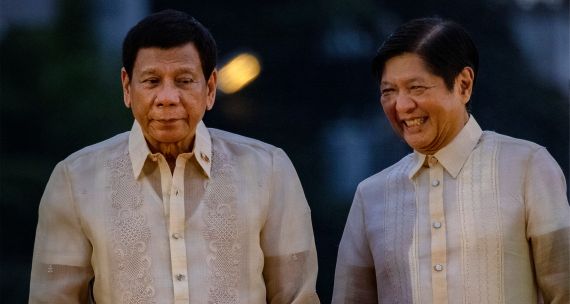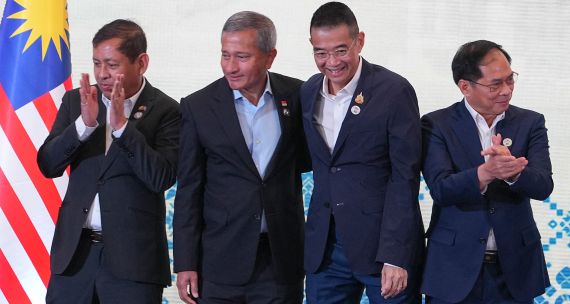As we say goodbye to 2015 on our way to a brand new year, APF Canada’s crack research team has compiled a list of key stories to watch in the Canada-Asia dynamic and current events in Asia in 2016.
And this year we invite you to cast your own vote for the story you feel will be the most important to the Asia Pacific region in the year ahead.
From trade and investment, to the environment and security, to politics and technology, here’s what we’ll be watching in 2016:
1. ISIS in Asia?
The Islamic State in Iraq and Syria (ISIS) is reportedly setting up shop in Muslim parts of Southeast Asia. Armed insurgency groups in the region are reportedly throwing in their lot with ISIS after failing to gain any significant support for their causes at home.
In September, a Filipino militant group kidnapped four foreigners, including two Canadians, from a luxury resort in southern Philippines. A ransom video released a couple of weeks later showed militants holding their prisoners, with an ISIS flag in the background.
Authorities claim these homegrown fighters are flying the ISIS colours in an attempt to gain access to funds from abroad. Regardless, governments in the region claim they are taking the ISIS threat seriously.
2. Crowdfunding in Asia
China, India, South Korea, and ASEAN member states, among others, have embraced crowdfunding as a valuable method of fundraising. Crowdfunding fills the funding gap between government grants and venture capital and provides local entrepreneurs with seed capital to jumpstart their projects.
To better regulate this activity, several Asian governments have begun adjusting their legal systems to prevent cyberfraud and illegal fundraising activities. China’s Security Commission, for example, is in the midst of drafting new rules that will set the parameters of these activities. Meanwhile, South Korea’s National Assembly recently passed laws to fully legitimize crowdfunding.
In 2016, we can expect to see an increased use of crowdfunding in emerging and developing Asian economies with rising Internet penetration, particularly in Southeast Asia, encouraging further SME growth in Asia Pacific.
3. Trade Politics in Asia
In October 2015, the 12 negotiating members of the Trans-Pacific Partnership (TPP) announced they had reached an agreement. In 2016, the ratification process begins.
In Japan, Prime Minister Abe faces opposition from farm lobbies, and will want to pass the TPP prior to the 2016 upper house elections in the summer. In Vietnam, the concessions on state-owned enterprises may ease ratification. In Malaysia, PM Najib may see pushback from those in his own party worried about the status of ethnically Malay dominated state-owned enterprises, the operations of which could be constrained by the TPP’s ‘State-Owned Enterprises and Designated Monopolies’ chapter. Ratification will be less contentious in the wealthy Southeast Asian micro-states of Brunei and Singapore.
Meanwhile, the Philippines and Indonesia have declared their intent to join, though significant domestic hurdles exist in both countries. Taiwanese officials and opposition leaders have expressed interest, but an election in the new year will delay any action. Thailand, a country tightly integrated with Japan’s auto sector, will feel the most economic pressure to join. How vigorously these bids are pursued will likely depend on the speed and success of ratification in the current member states.
4. Canada’s Free Trade Agreements in Asia
Although all eyes in 2016 will be on the ratification of the TPP, the real test for Prime Minister Trudeau’s government will be in the advancement of new Free Trade Agreements (FTA) still under negotiation. The Canada-India Comprehensive Economic Partnership Agreement will feature prominently in the coming year’s trade talks, as will the potential Canada-China FTA.
With Australia and South Korea concluding FTAs with China in 2015, the Canadian government may attempt to drum up domestic support in order to lower trade barriers to the world’s second-largest economy. A recent APF Canada poll showed that a majority of Canadians are against the idea of an FTA with China, with 48 per cent opposed and 42 per cent in support. The Canadian public will need to be convinced that these new agreements will not harm the country’s labour, intellectual property, and environmental standards.
5. China’s 13th Five-Year Plan: A New Paradigm for Global Development?
In November 2015, China released its 13th Five-Year National Socio-economic Development Plan, and 2016 will be the first year of its implementation. The plan lays out a blueprint for the country’s development over the next five years, aiming to double its 2010 GDP and per capita income by 2020 through “innovative, co-ordinated, green, open and shared” development.
The new plan is critical to China’s economic restructuring as its economy enters a “new normal” of slower yet healthier economic growth. It will continue opening the country to international trade and investment. The focus, however, is on encouraging more sustainable and environmentally friendly development and a more innovation and consumption-driven economy. Programs to encourage mass innovation and entrepreneurship, and to implement the One Belt, One Road initiative, will be brought into full play during this new period.
6. Asian Infrastructure Investment Bank
In 2016, the Asian Infrastructure Investment Bank (AIIB) will officially become operational. It will be a multilateral development bank led by China. The bank’s president-designate has stated that in the third quarter of 2016, the bank will launch its first focus area projects.
The AIIB has an initial subscribed capital base of US$50B and it is estimated that within 20 years it will have an annual lending power roughly equal to that of the World Bank. Canada, as of yet, is not a member of the bank. If/when it chooses to join, Canada will be able to play an active role in shaping the development impact of the bank and in facilitating the participation of Canadian companies in the bank's infrastructure projects.
7. Elections in Taiwan and the Philippines
Taiwan will hold presidential and legislative elections on January 16. The opposition Democratic Progressive Party (DPP) candidate, Ms. Tsai Ing-wen, is leading by a comfortable margin, and her victory would add to the DPP’s big win in recent municipal elections. But it could also introduce considerable uncertainty in relations with the Mainland, especially in regards to how the DPP currently interprets the “status quo” in cross-Strait relations, and as identity politics in Taiwan vis-à-vis the Mainland have emerged as a prominent issue. A Tsai victory would certainly mark a milestone in Taiwan politics: its first-ever female president.
In May, Filipinos will elect a new president. Grace Poe, a popular candidate who was leading in early polling, was disqualified on December 1st for not meeting residency requirements, but there are plenty of other colorful candidates left in the race, not least of whom is the long-time Mayor of Davao, Rodrigo Duterte, aka “The Punisher.” He is accused of condoning many extrajudicial killings of alleged criminals.
8. Myanmar’s Transition of Power
In November 2015, Aung San Suu Kyi’s party, the National League for Democracy (NLD), won the general election, but it won’t take power until March 2016. NLD legislators will take office facing a host of issues: a creaking national ceasefire agreement, racial tensions and refugees, as well as the significant challenge of working with the powerful military in drafting legislation to continue the country’s economic growth.
One of the first challenges the new government faces is finding a president that will be acceptable to the military, ethnic leaders, and NLD. The ability for the future president to navigate among these groups will be critical in Myanmar’s transition to democratic rule.
9. Implementing Climate Change Policies Post-COP 21
In December 2015, over 190 countries met in Paris to negotiate a new agreement to reduce global carbon emissions. Unlike previous climate negotiations, countries submitted voluntary carbon reduction targets in advance of the conference. Though the commitments are not legally binding, countries have agreed to periodically review and report their emissions status. Asia is key to finding a carbon reduction solution–approximately a third of the global annual carbon emissions by volume originate from India and China.
2016 will be a crucial year for the implementation of domestic policies for meeting carbon emission reduction targets, but many countries in Asia face capacity challenges. The international community has created a number of mechanisms and financing initiatives to help address these challenges. In 2016, we’ll watch how implementation of these fold out.
10. More Women in the Workforce?
The United Nations estimates that limits on women’s participation in the workforce across the Asia Pacific costs the regional economy US$89B annually. Getting more women into the workforce on equal footing with men could add between US$12T and US$28T to global annual GDP by 2025.
Female labour participation is variable across the region, ranging from a low of 16 per cent in Afghanistan to 75 per cent in Myanmar. Amongst OECD countries, Japan has long-struggled with the lowest level of women's participation (49%), but PM Abe is nevertheless grappling with falling birthrates and an aging population. China has one of the highest global female employment rates (64%); how Chinese families respond to the new “two-child” policy will be key in 2016.
Countries like South Korea and Singapore, with 50 per cent and 59 per cent female workforce participation respectively, are also seeing women in their 30s increasingly choose to start families and not return to full-time jobs. In 2016, we’ll be watching how Asian governments and women juggle between demographic and economic needs.
Bonus
. . . 11. Balloon Powered Internet
According to the World Bank, over 80 per cent of India’s and Indonesia’s combined population of 1.5 billion people lack access to the Internet. Technology companies like Google and Facebook are looking to capitalize on these untapped markets. Google’s “Project Loon,” which began testing in 2013, proposes to extend Internet coverage to remote areas with solar-powered balloons flying 20 km above the Earth’s surface, bypassing the need for high-cost traditional infrastructure.
The system can already transmit mobile 4G data and may one day replace network towers. In 2016, we’ll see an expansion of projects throughout Asia, most notably in Indonesia and India. Project Loon’s vice president said the goal for 2016 is a continuous ring of balloons around the world in the southern hemisphere.



